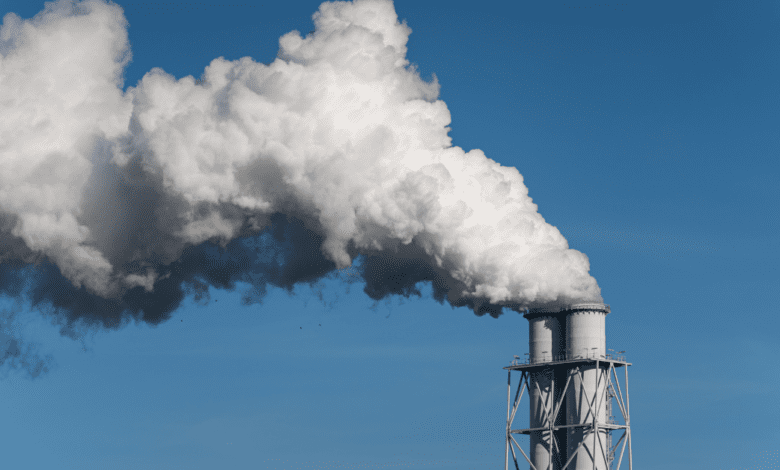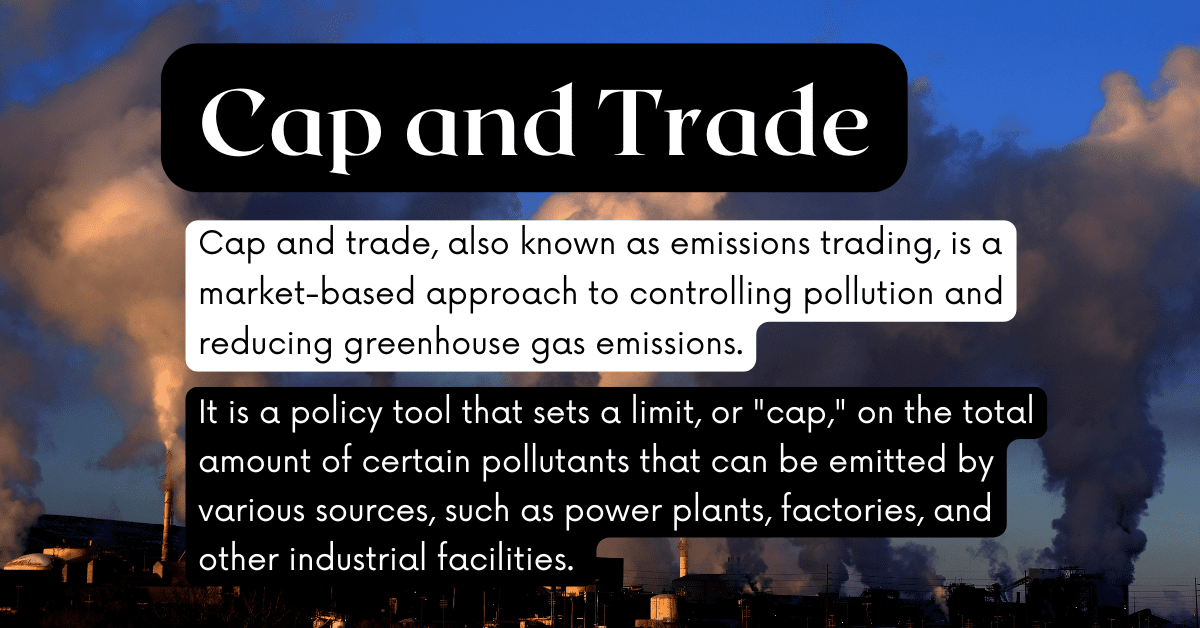Understanding Cap and Trade: All You Need to Know

What is Cap and Trade?
Cap and trade, also known as emissions trading, is a market-based approach to controlling pollution and reducing greenhouse gas emissions. It is a policy tool that sets a limit, or “cap,” on the total amount of certain pollutants that can be emitted by various sources, such as power plants, factories, and other industrial facilities. Within this cap, companies or entities can buy and sell, or “trade,” emission allowances, creating a financial incentive to reduce emissions.
The cap is typically lowered over time, forcing companies to find ways to reduce their emissions or purchase additional allowances. This system aims to achieve environmental goals in the most cost-effective manner, as companies can choose the most efficient and economical way to reduce their emissions.
The History and Purpose
The concept of cap and trade has its origins in the 1970s, when the United States implemented a successful program to reduce acid rain-causing sulfur dioxide emissions. Since then, cap and trade has been adopted and implemented in various forms around the world, particularly as a strategy to address climate change and reduce greenhouse gas emissions.
The primary purpose of cap and trade is to provide a flexible and cost-effective way for governments and industries to achieve environmental goals. By setting a cap on emissions and allowing the trading of allowances, cap and trade systems create a financial incentive for companies to invest in cleaner technologies and find innovative ways to reduce their emissions.
How Cap and Trade Works
The basic mechanism of a cap and trade system consists of the following steps:
- Setting the Cap: The government or regulatory body sets a cap on the total amount of emissions that can be released within a given time period, typically a year.
- Distributing Allowances: The government then distributes or auctions off a number of emission allowances, each representing the right to emit a certain amount of the pollutant (e.g., one ton of carbon dioxide).
- Trading Allowances: Companies that are subject to the cap can buy, sell, or trade these allowances on a secondary market, depending on their emissions levels and the cost of reducing emissions.
- Compliance and Monitoring: Companies must monitor and report their emissions, and at the end of the compliance period, they must surrender a number of allowances equal to their actual emissions. Failure to do so results in penalties.
- Lowering the Cap: Over time, the government gradually lowers the overall cap, forcing companies to further reduce their emissions or purchase additional allowances.
This market-based approach allows companies to determine the most cost-effective way to meet their emission reduction targets, whether it’s by investing in cleaner technologies, improving efficiency, or purchasing additional allowances.
Also read: What is Renewable Energy: A Sustainable Solution for a Greener Future
Benefits of Cap and Trade
Cap and trade systems offer several benefits:
- Environmental Effectiveness: By setting a hard cap on emissions, cap and trade systems can achieve specific environmental targets, such as reducing greenhouse gas emissions or improving air quality.
- Cost-Effectiveness: The flexibility of trading allowances allows companies to find the most cost-effective ways to reduce their emissions, rather than being subject to a one-size-fits-all regulation.
- Innovation and Technological Advancement: The financial incentives created by cap and trade systems encourage companies to invest in and develop new, cleaner technologies to reduce their emissions.
- Revenue Generation: Governments can generate revenue by auctioning off emission allowances, which can be used to fund environmental initiatives, support affected industries, or provide assistance to low-income households.
- Fairness and Equity: Cap and trade systems can be designed to address concerns about fairness and equity, such as by providing free allowances to certain industries or sectors, or by investing revenue in disadvantaged communities.
Challenges and Criticisms

While cap and trade systems offer many benefits, they also face several challenges and criticisms:
- Complexity and Administrative Burden: Implementing and managing a cap and trade system can be complex, requiring robust monitoring, reporting, and enforcement mechanisms to ensure the integrity of the system.
- Potential for Windfall Profits: If allowances are distributed for free, companies may receive windfall profits by passing on the cost of those allowances to consumers, rather than investing in emissions reductions.
- Volatility in Allowance Prices: The price of emission allowances can be subject to significant volatility, which can create uncertainty for companies and make long-term planning more difficult.
- Potential for Leakage: If a cap and trade system is not implemented globally, there is a risk of “carbon leakage,” where companies shift their emissions-intensive activities to regions without similar regulations.
- Equity Concerns: Cap and trade systems can have disproportionate impacts on low-income communities and industries, which may require additional policies to address these concerns.
Also read: The Hidden Dangers of Thermal Pollution
Case Studies of Successful Programs
Several cap and trade programs have been implemented around the world, with varying degrees of success. Some notable examples include:
- European Union Emissions Trading System (EU ETS): Launched in 2005, the EU ETS is the largest and longest-running cap and trade program in the world, covering over 11,000 power plants and industrial facilities across 31 countries.
- California Cap and Trade Program: Established in 2013, the California program is the first economy-wide cap and trade program in the United States, covering a wide range of sectors, including electricity, transportation, and industry.
- Regional Greenhouse Gas Initiative (RGGI): A cap and trade program for the power sector in the Northeastern United States, RGGI has been operational since 2009 and has achieved significant reductions in carbon dioxide emissions.
- New Zealand Emissions Trading Scheme: New Zealand’s program, launched in 2008, covers a range of sectors, including forestry, energy, and industrial processes, and has been an important part of the country’s efforts to meet its climate change commitments.
These case studies demonstrate the potential for cap and trade systems to effectively reduce greenhouse gas emissions and drive investment in clean technologies, while also highlighting the importance of careful design and implementation to address challenges and ensure the program’s long-term success.
Implications of Cap and Trade on Businesses and the Economy
The implementation of a cap and trade system can have significant implications for businesses and the broader economy:
- Compliance Costs: Companies subject to the cap will face additional costs to monitor, report, and purchase or trade emission allowances, which can impact their profitability and competitiveness.
- Investment Decisions: The price of allowances and the trajectory of the cap can influence a company’s decisions to invest in emissions-reducing technologies, energy efficiency measures, or alternative production processes.
- Competitiveness Concerns: Industries that are energy-intensive and trade-exposed may face concerns about their ability to compete with companies in regions without similar carbon pricing policies, leading to potential “carbon leakage.”
- Macroeconomic Impacts: The costs and benefits of a cap and trade system can have broader macroeconomic implications, such as changes in energy prices, employment, and overall economic growth, which policymakers must consider.
- Distributional Effects: The implementation of a cap and trade system can have uneven impacts across different sectors, regions, and socioeconomic groups, requiring careful policy design and complementary measures to address equity concerns.
Also read: Understanding the Difference: Bioaccumulation vs Biomagnification
Cap and trade vs. other Climate Change Mitigation Strategies
Cap and trade is one of several policy tools available to governments and policymakers for addressing climate change and reducing greenhouse gas emissions. Other strategies include:
- Carbon Taxes: A direct tax on carbon emissions, which provides a price signal to incentivize emissions reductions.
- Command-and-Control Regulations: Mandates and standards that directly limit or prohibit certain emissions or activities.
- Subsidies and Incentives: Financial support for the development and adoption of clean technologies and low-emission practices.
- Voluntary Initiatives: Voluntary programs and commitments by businesses, organizations, and individuals to reduce their carbon footprint.
Each approach has its own strengths, weaknesses, and tradeoffs, and policymakers often employ a combination of these strategies to achieve their climate change mitigation goals. The choice of policy tool(s) depends on factors such as political feasibility, economic impacts, environmental effectiveness, and social equity considerations.
The Future of Cap and Trade
As the world continues to grapple with the urgent challenge of climate change, the role of cap and trade systems is likely to evolve and expand in the coming years:
- Expansion and Linkage: More countries and regions are expected to adopt cap and trade programs, with the potential for these systems to be linked, creating larger, more integrated carbon markets.
- Increased Ambition: Existing cap and trade programs may tighten their emissions caps and adjust their design features to drive deeper emissions reductions and further incentivize clean technology investments.
- Sectoral Expansion: While many current cap and trade systems focus on the power and industrial sectors, future programs may expand to cover a wider range of sectors, such as transportation, agriculture, and waste management.
- Technological Advancements: Innovations in areas like carbon capture and storage, renewable energy, and energy efficiency may enhance the effectiveness and efficiency of cap and trade systems.
- Equity and Just Transition: Policymakers will likely place greater emphasis on ensuring that the transition to a low-carbon economy is equitable and that the benefits and burdens are distributed fairly across different communities and stakeholders.
As the global response to climate change evolves, cap and trade systems will continue to play a crucial role in driving cost-effective emissions reductions and supporting the transition to a more sustainable future.
To learn more about the latest developments and trends in cap and trade programs, subscribe to our newsletter or visit our website for in-depth analysis and expert insights.




